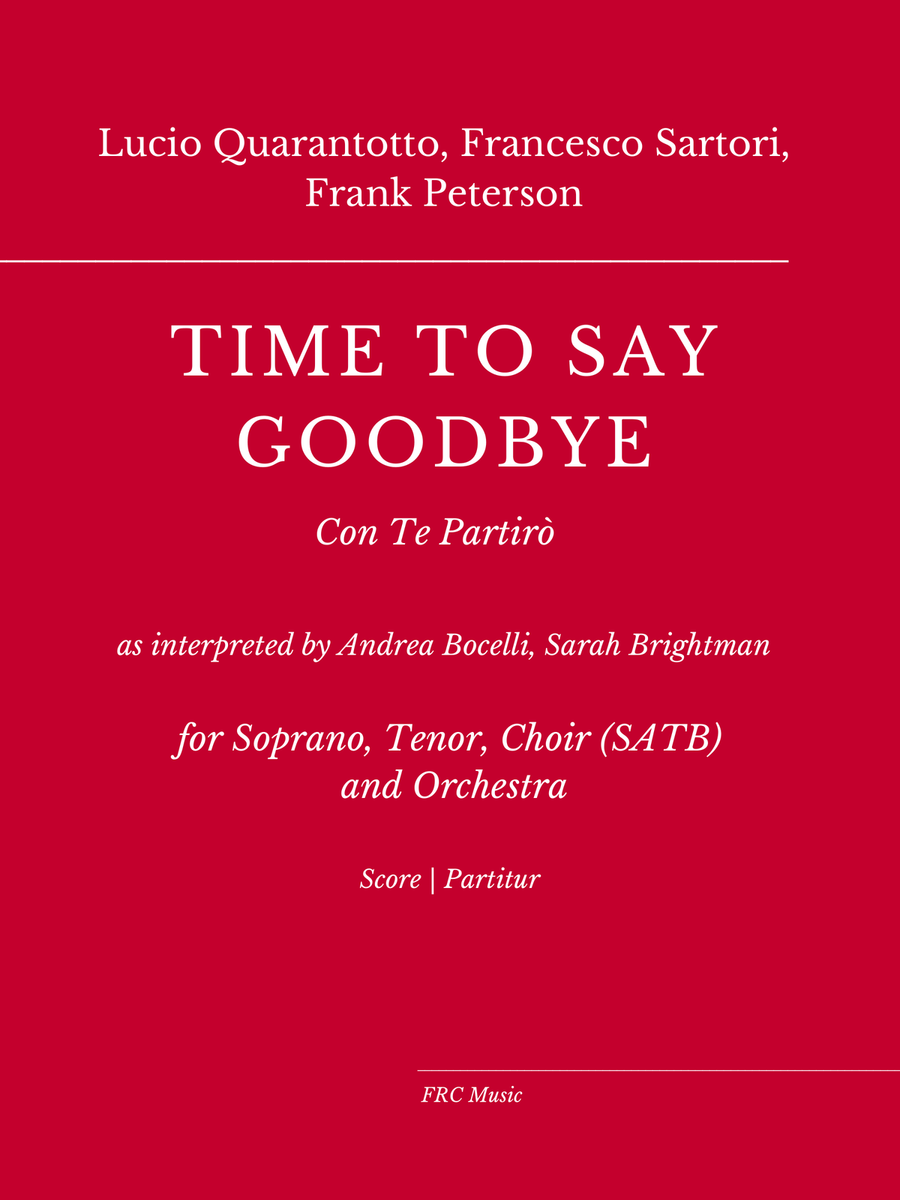Full Orchestra - Level 3 - Digital Download SKU: A0.1139872 By Andrea Bocelli. By Francesco Sartori and Lucio Quarantotto. Arranged by Flavio Regis Cunha. 20th Century,Contest,Festival,Opera,Pop,Wedding. Score and Parts. 59 pages. Flavio Regis Cunha #740145. Published by Flavio Regis Cunha (A0.1139872). Introducing the most romantic and emotive piece of music composed by two legendary Italian artists - Lucio Quarantotto and Francesco Sartori - 'Con Te Partiro (Time to Say Goodbye). This timeless piece of music has the power to hit the heartstrings and the mind in equal measure. It is the perfect choice for any orchestra or group of musicians wanting to create an atmosphere of emotion in their performance. Â Let this venerable music take your performance to a new level of excellence as you transport your audience to a world of romance and deep emotion. 'Con Te Partiro (Time to Say Goodbye) will be sure to create a powerful, lasting impression on even your toughest critics. Â Download your copy today and add a classic touch to your music.Sheet music download, complete score and all individual instruments and voice parts. Advanced Intermediate.Format: Concert, 9 x 12 inches59 pages.Time To Say Goodbye (FULL SCORE) Con te partiro for Soprano, Tenor and Orchestra. Andrea Bocelli and Sarah Brightman: Time To Say Goodbye. Live From Teatro Del Silenzio, Italy / 2007 Artist Andrea Bocelli & Sarah Brightman Composers Frank Peterson, Lucio Quarantotto, Francesco Sartori Complete version of TIME TO SAY GOODBYE from Andrea Bocelli & Sarah Brightman for Soprano, Tenor, Choir and Orchestra.Orchestration: FLUTE 1, FLUTE 2, OBOE 1, OBOE 2, CLARINET 1 IN Bb, CLARINET 2 IN Bb, BASSOON 1, BASSOON 2 , HORN 1 IN F, HORN 2 IN F, HORN 3 IN F, TRUMPET 1 IN Bb, TRUMPET 2 IN Bb, TROMBONE 1, TROMBONE 2, BASS TROMBONE, TUBA, PERCUSSION (Timpani, Snare Drum, Bass Drum, Cymbals) - 4 players, HARP, PIANO, CHOIR (SATB), VIOLIN 1, VIOLIN 2, VIOLA, VIOLONCELLO, DOUBLE BASS.Program NotesCon Te Partiro (Time To Say Goodbye), composed by Lucio Quarantotto and Francesco Sartori, is an Italian aria of immense power and emotional intensity. The iconic performance of the song was delivered by world renowned artists Andrea Bocelli and Sarah Brightman at the Teatro del Silenzio in Italy during 2007. The song emerged from a commingling of their beautiful voices in perfect harmony, ultimately delivering an emotionally charged performance that transcended beyond language barriers and touched the souls of people around the world. Â This heartfelt performance of Con Te Partiro (Time To Say Goodbye) takes its audience on a journey. From the emotion-filled verses, to the powerful build up of the instruments supporting the crescendo of the chorus, the energy and emotion reach a crescendo before slowly fading out to a beautiful and melancholic farewell. The combination of affective singing and passionate playing of the instruments created an intimate atmosphere, leaving the audience with a sense of heartache and clarity. Â This song represents a beautiful goodbye to a loved one, and the emotions portrayed echo each listener's hope for a meaningful and beautiful farewell. With its powerful vocals and evocative arrangement, Con Te Partiro (Time to Say Goodbye) by Lucio Quarantotto and Francesco Sartori will remain a timeless classic.
